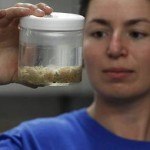ATMOCEAN, a firm based in Santa Fe, NM with Philip W. Kithil at the helm, is according to their website the company is “at the forefront of the emerging Hurricane and Global Warming Mitigation Industry.” What is that you ask?
In their own words…
Our patents-pending Atmocean technology is based on a wave-activated pump that brings cold water from the deep ocean to the surface, to cool sea surface temperatures and potentially reduce hurricane damage to onshore and offshore property and infrastructure, and save lives. For each 0.5 degree Celsius drop in surface water temperature, hurricane peak winds may decrease by up to 10%, according to recent scientific reports. The pump requires no external power; is low-cost and efficient; and can be selectively enabled to reduce sea surface temperature in the path of an approaching hurricane. Pumps self-deploy when dropped into the ocean, and employ tethering and anchoring, if needed, to maintain their position.
I am unsure where to start with critique of this idea. In response to a talk Philip Kitchil gave at the 27th annual meeting of the American Meteorological Society’s conference on Hurricanes and Tropical Meteorology, Jeff Masters points to environmental concerns, technical problems, political issues, and legal problems with such a venture.
Kithil acknowledged that an evaluation of the ecological effects of injecting a large amount of cold water to the surface needs to be done. Such a large change to a significant region of the ocean is bound to have major and possibly negative consequences to fisheries and wildlife…It is not clear how long the cold water pumped to the surface will stay there–the cold water pumped to the surface is more dense than the water beneath it, and so will tend to sink, allowing warmer water beneath to replace it and warm the surface waters again…The array of pumps will lie across some very busy shipping lanes. Companies that operate deep draft vessels such as oil tankers are not going to be too happy about their ships having to take longer and more costly routes around the array…Residents on the coast hit by the modified storm will want to sue, and there will be many lawyers more than happy to take their case. I asked Dave Moran, Professor of Law at Wayne State University about this, and he assured me that those suing would have a very good case.
ATMOCEAN has conducted a field tests of a smaller pump and they state that “a preliminary experiment in Bermuda during December 2005 showed that a smaller prototype of the pumps (Ø 25 cm, 150 m long) worked and actually brought cold water up.” In that test the ocean surface was dropped 4 degrees C although the duration or extent of the cooling is not mentioned.
Obviously, it would take thousands of these pumps at $2800 a piece to ‘mitigate’ a hurricane to the estimated price tag of $2 billion just for the Gulf of Mexico plus 20% a year for maintenance. Who is going to pay for this? Kithil hopes taxpayers. According to this website
“Kithil hopes to convince Congress to fund his proposal suggesting that lawmakers create a “Hurricane Mitigation Trust Fund” similar to the Highway Trust Fund that funded the interstate highway system in the 1950’s.”
The folly doesn’t stop here. Kithil presented a poster at this years AGU. In which he proposes
“propagation of Salps is forced upwelling using Atmocean’s arrays of wave-driven deep ocean pumps to bring up large volumes of cold, nutrient-rich deep ocean to enhance the ocean’s primary production, absorbing CO2 and producing oxygen.”
The idea is that a phytoplankton bloom would uptake carbon leading to a salp population explosion. Consumption of the phytoplankton and excrement of waste would transport this carbon to the deep sea leading to a reduction of atmospheric CO2. The cost of this…$268 billion.
Of course this assumes that the organisms on the seafloor will not just respire most this carbon right back into the water column (they will), that carbon used for growth/reproduction of seafloor organisms will not return to the water column through respiration by predators (it will), the amount of carbon not respired will stay in sediment for long geologic periods (some will not), and the sea surface will not leach carbon dioxide into the atmosphere (it will).





Its not related that much to the article, but there has been a lot of talk lately about global warming. Mostly because New England has been unusually warm this year. It is not just a freak occurence, because its never been 65 degrees in early January in New England. The record temperature was set at 68 degrees in boston, which was 6 degrees higher than the previous. It couldn’t have just been a warm front, so everyone is using global warming to explain it. Is this necessarily the main thing causing the amazing weather in New England. I know I should just be counting my blessings with all the good weather, but I am used to snow so it is very odd. Any answer would be appreciated greatly
Kevin take a look at El Nino, Global Warming, and Anomalous U.S. Winter Warmth
That link should have been http://www.realclimate.org/index.php/archives/2007/01/el-nino-global-warming-and-anomalous-winter-warmth/